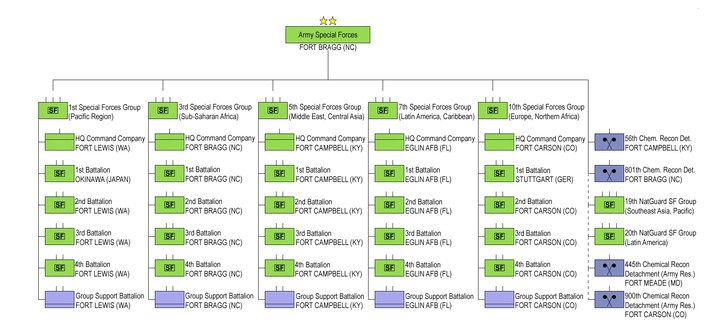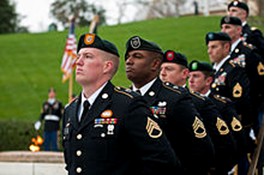
Special Forces (United States Army)
USinfo | 2012-11-26 10:45
| U.S. Army Special Forces | |
 United States Army Special Forces shoulder sleeve insignia |
|
| Active | 19 June 1952 – present |
| Country | United States of America |
| Branch | United States Army |
| Type | Special operation |
| Role |
Primary tasks: Unconventional warfare Foreign internal defense Special reconnaissance Direct action Counter-terrorism Other roles: Hostage rescue Counterproliferation Information operations Humanitarian missions |
| Part of |
United States Special Operations Command (USSOCOM) United States Army Special Operations Command (USASOC) |
| Nickname | Green Berets, Quiet Professionals,Soldier-Diplomats, Snake Eaters, Bearded Bastards |
| Motto |
De oppresso liber U.S. Army's translation: "To Liberate the Oppressed" |
| Engagements |
Cold War Vietnam War El Salvador Operation Urgent Fury Operation Just Cause Gulf War Somalia Operation Uphold Democracy Kosovo Operation Enduring Freedom Iraq War Afghanistan War |
The United States Army Special Forces, also known as the Green Berets because of their distinctive service headgear, are a special operations force tasked with five primary missions: unconventional warfare (the original and most important mission of Special Forces), foreign internal defense, special reconnaissance, direct action, and counter-terrorism. The first two emphasize language, cultural, and training skills in working with foreign troops. Other duties include hostage rescue, combat search and rescue (CSAR), security assistance, peacekeeping, humanitarian assistance, humanitarian demining, counter-proliferation, psychological operations, manhunts, and counter-drug operations; other components of the United States Special Operations Command or other U.S. government activities may also specialize in these secondary areas.Many of their operational techniques are classified, but some nonfiction works and doctrinal manuals are available.
Currently, Special Forces units are deployed in Operation Enduring Freedom. As a special operations unit, Special Forces are not necessarily under the command authority of the ground commanders in those countries. Instead, while in theater, SF soldiers may report directly to United States Central Command, USSOCOM, or other command authorities.
The Central Intelligence Agency's (CIA) highly secretive Special Activities Division (SAD) and more specifically its elite Special Operations Group (SOG) recruits soldiers from the Army's Special Forces.Joint Army Special Forces and CIA operations go back to the famed MACV-SOG during the Vietnam War.This cooperation still exists today and is seen in the War in Afghanistan.

Mission
The main mission of the Special Forces was to train and lead unconventional warfare (UW) forces, or a guerrilla force in an occupied nation that no one is allowed to know. The Special Forces are the only U.S. Special Operations Force (SOF) trained to employ UW. The 10th Special Forces Group was the first deployed SF unit, intended to operate UW forces behind enemy lines in the event of a Warsaw Pact invasion of Western Europe. As the United States became involved in Southeast Asia, it was realized that specialists trained to lead guerrillas could also help defend against hostile guerrillas, so SF acquired the additional mission of Foreign Internal Defense (FID), working with Host Nation (HN) forces in a spectrum of counter-guerrilla activities from indirect support to combat command.
Special Forces personnel qualify both in advanced military skills and the regional languages and cultures of defined parts of the world. While they have a Direct Action (DA) capability, other units, such as Rangers, are more focused on overt direct action raids conducted in uniform but potentially behind enemy lines. SF personnel have the training to carry out covert DA, and other missions, including clandestine SR. Other missions include peace operations, counter-proliferation, counter-drug advisory roles, and other strategic missions. As strategic resources, they report either to USSOCOM or to a regional Unified Combatant Command.
SF team members work closely together and rely on one another under isolated circumstances for long periods of time, both during extended deployments and in garrison. Because of this, they develop clannish relationships and long-standing personal ties. SF non-commissioned officers (NCO) often spend their entire careers in Special Forces, rotating among assignments to detachments, higher staff billets, liaison positions, and instructor duties at the U.S. Army John F. Kennedy Special Warfare Center and School (USAJFKSWCS). Special Forces officers, on the other hand, historically spend a limited amount of time early in their careers assigned to SF detachments. They are then required to move to staff positions or to higher command echelons. With the creation of USSOCOM, SF commanders have risen to the highest ranks of U.S. Army command, including command of USSOCOM, the Chief of Staff of the United States Army, and Chairman of the Joint Chiefs of Staff.

History
The United States Army Special Forces were formed in 1952, initially under the U.S. Army Psychological Warfare Division headed by then Brigadier General Robert A. McClure.
Since their establishment in 1952, Special Forces soldiers have operated in Vietnam, El Salvador, Panama, Haiti, Somalia, Bosnia, Kosovo, Afghanistan, Iraq, the Philippines, and, in an FID role, Operation Enduring Freedom - Horn of Africa, which was transferred to Africa Command in 2008.
Organizational structure
Special Forces groups
U.S. Army Special Forces is divided into five active duty (AD) and two Army National Guard (ARNG) Special Forces groups. Each Special Forces Group (SFG) has a specific regional focus. The Special Forces soldiers assigned to these groups receive intensive language and cultural training for countries within their regional area of responsibility (AOR).[13] Due to the increased need for Special Forces soldiers in the War on Terror, all Groups—including those of the National Guard (19th and 20th SFGs)—have been deployed outside of their areas of operation (AOs), particularly to Iraq and Afghanistan. A recently released report showed Special Forces as perhaps the most deployed SOF under SOCOM, with many soldiers, regardless of Group, serving up to 75% of their careers overseas, almost all of which had been to Iraq and Afghanistan.
Until recently an SF group has consisted of three battalions, but since the Department of Defense has authorized U.S. Army Special Forces Command to increase its authorized strength by one third, a fourth battalion will be activated in each active component group by 2012.
A Special Forces group is historically assigned to a Unified Combatant Command or a theater of operations. The Special Forces Operational Detachment C or C-detachment (SFODC) is responsible for a theater or a major subcomponent, which can provide command and control of up to 18 SFODAs, three SFODB, or a mixture of the two. Subordinate to it are the Special Forces Operational Detachment Bs or B-detachments (SFODB), which can provide command and control for six SFODAs. Further subordinate, the SFODAs typically raise company- to battalion-sized units when on unconventional warfare missions. They can form 6-man "split A" detachments that are often used for Strategic Reconnaissance (SR).
Share this page



















